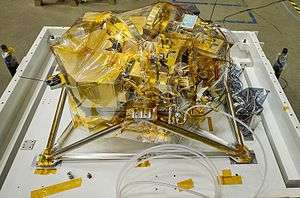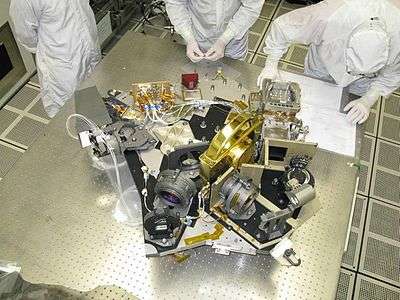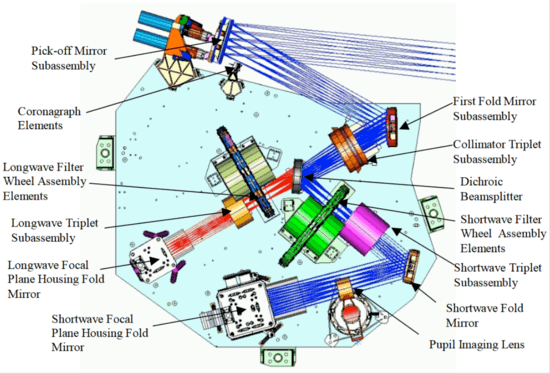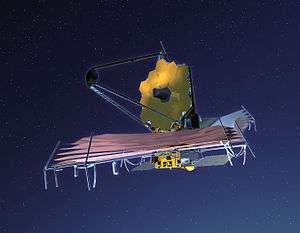NIRCam

.jpg)
NIRCam is an instrument aboard the to-be-launched James Webb Space Telescope. It has two major tasks, as an imager from 0.6 to 5 micron light wavelength, and as a wavefront sensor to keep the 18-section mirrors functioning as one.[1][2] In other words, it is a camera and is also used to provide information to align the 18 segments of the primary mirror.[3] It is an infrared camera with ten mercury-cadmium-telluride (HgCdTe) detector arrays, and each array has an array of 2048 X 2048 pixels.[1][2] The camera has a field of view of 2.2 X 2.2 arc min with an angular resolution of 0.07 arcsec at 2 microns.[1] NIRcam is also equipped with coronagraphs, which helps to collect data on exoplanets near stars. It helps with imaging anything next to a much brighter object, because the coronagraph blocks that light.[2] NIRcam is housed in the Integrated Science Instrument Module, to which it is attached physically by struts.[3][4][5][6] It is designed to operate at 37 kelvin (roughly minus 400 degrees Fahrenheit), so it can detect infrared light at this wavelength.[3][7] It is connected to the ISIM by struts and thermal straps connect to heat radiators, which helps maintain its temperature.[3] The Focal Plane Electronics operated at 290 kelvin.[3]
NIRcam should be able to observe as faint as magnitude +29 with a 10000-second exposure (about 2.8 hours).[8] It makes these observations in light from 0.6 (600 nm) to 5 microns (5000 nm) wavelength.[4] It can observe in two fields of view, and either side can do imaging, or from the capabilities of the wave-front sensing equipment, spectroscopy.[9] The wavefront sensing is much finer than the thickness of an average human hair.[10] It must perform at an accuracy of at least 93 nanometers and in testing it has even achieved between 32 and 52 nm.[10] A human hair is thousands of nanometers across.[10]
Main
Components

Wavefront sensors components include:[9]
- Dispersed Hartmann sensors
- Grisms
- Weak lenses
Parts of NIRCam:[11]
- Pick-off mirror
- Coronograph
- First-fold mirror
- Collimator lenses
- Dichroic beam splitter
- Longwave filter wheel
- Longwave camera lens group
- Longwave focal plane
- Shortwave filter wheel assembly
- Shortwave camera lens group
- Shortwave fold mirror
- Pupil imaging lens
- Shortwave focal plane
Overview
NIRCam has two complete optical systems for redundancy.[3] The two sides can operate at the same time, and view two separate patches of sky; the two sides are called side A and side B.[3] The lenses used in the internal optics are triplet refractors.[3] The lens materials are lithium fluoride (LiF), a barium fluoride (BaF2) and zinc selenide (ZnSe).[3] The triplet lenses are collimating optics.[12] The biggest lens as 90 mm of clear apature.[12]
The observed wavelength range is broken up into a high and low band.[13] The low band goes from 0.6 to 2.3 microns and the high band goes from 2.4 to 5 microns; both have the same field of view and access to a coronagraph.[13] The lower band has finer plate scale with twin quad arrays of 2048x2048 arrays, while the high band has two 2048x2048 arrays.[13] Each side of the NIRCam views a 2.2 arcminute by 2.2 arcminute patch of sky in both the high and the low band; however, the low band has twice the resolution.[12] The high band has one array per side (two overall), and the low band has four arrays per side, or 8 overall.[12] Side A and Side B have a unique field of view, but they are adjacent to each other.[12] In other words, the camera looks at two 2.2 arcminute wide fields of view that are next to each other, and each of these views is observed in the high and low band, but the low band has twice the resolution of the higher wavelength band.[12]
The builders of NIRCam are the University of Arizona and company Lockheed Martin, in cooperation with the U.S. Space agency, NASA.[2] NIRCam was completed in July 2013 and it was shipped to Goddard Spaceflight Center, which is the NASA center managing the JWST project.[7] NIRCam was also delivered to NASA in March 2014.[10]
NIRCam's four major science goals include:
1. Exploring the formation and evolution of the first luminous objects and revealing the reionization history of the Universe.
2.Determining how objects seen in the present day (galaxies, active galaxies, and clusters of galaxies) assembled and evolved out of gas, stars, metals present in the early Universe.
3.Improve our understanding of the birth of stars and planetary systems.4.Study the physical and chemical conditions of objects in our solar system with a goal of understanding the origin of the building blocks of life on Earth.
— Science Opportunities with the Near-IR Camera (NIRCam) on the James Webb Space Telescope (JWST) Biechman, et al.[14]
Electronics
.jpg)
Data from the image sensors (Focal Plane Arrays) is collected by the Focal Plane Electronics and sent to the ISIM computer.[3] The data between the FPE and the ISIM computer is transferred by SpaceWire connection.[3] There are also Instrument Control Electronics (ICE).[3] The Focal Plane Arrays contain 40 million pixels.[7]
The FPE provides or monitors the following for the FPA:[7]
- Regulated power
- Output data synchronization
- Temperature control
- Operational mode controls
- Image data conditioning
- Image data amplification
- Image data digitization
Filters
NIRcam includes filter wheels that allow the light coming in from the optics to be sent through a filter before it is recorded by the sensors.[14] The filters have a certain range in which they allow light to pass, blocking the other frequencies; this allows operators of NIRCam some control over what frequencies are observed when making an observation with the telescope.[14]
By using multiple filters the redshift of distant galaxies can be estimated by photometry.[14]
NIRcam filters:[14]
- Below deadband 1, from lower to higher wavelength:
- F070W
- F090W
- F115W
- F150W
- F200W
- F277W
- F356W
- F2444W
- From deadband 1 to 2, from lower to higher wavelength:
- F140M
- F162M
- F182M
- F210M
- F250M
- F300M
- F335M
- F360M
- F410M
- F430M
- F460M
- F480M
- From deadband 2 to 3, from lower to higher wavelength:
- F4160N
- F187N
- F212N
- F323N
- F405N
- F466N
- F470N
- From deadband 3 to 5, from lower to higher wavelength:
- F150W2
- F322W2
Labeled diagram

See also
- Optical Telescope Element
- James Webb Space Telescope timeline
- Near Infrared Camera and Multi-Object Spectrometer (defunct NIR Hubble instrument)
- Wide Field Camera 3 (current NIR Hubble instrument)
- MIRI (Mid-Infrared Instrument) (JWST's 5-28 micron camera/spectrograph)
- Infrared Array Camera (Spitzer near- to mid-infrared camera)
References
- 1 2 3 "NIRCAM". Retrieved 5 December 2016.
- 1 2 3 4 "The James Webb Space Telescope". Retrieved 5 December 2016.
- 1 2 3 4 5 6 7 8 9 10 11 12 NIRCam Instrument Overview
- 1 2 "NIRCAM". Retrieved 6 December 2016.
- ↑ "The James Webb Space Telescope". Retrieved 6 December 2016.
- ↑
- 1 2 3 4 "NirCam". www.lockheedmartin.com. Retrieved 2017-01-21.
- ↑
- 1 2
- 1 2 3 4 "Lockheed Martin Readies One of the Most Sensitive IR Instruments Ever Made for NASA Telescope". www.lockheedmartin.com. Retrieved 2017-01-21.
- ↑ "NIRCam for JWST". Retrieved 5 December 2016.
- 1 2 3 4 5 6
- 1 2 3
- 1 2 3 4 5
External links
| Wikimedia Commons has media related to Near-Infrared Camera. |
- JWST NASA website - NIRCam
- NIRCam
- NIRCam gallery on Flickr
- NIRCam pocket guide (2 page .pdf)
- Slitless spectroscopy with the James Webb Space Telescope Near-Infrared Camera (JWST NIRCam)
